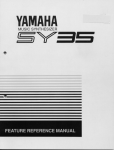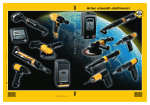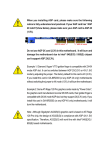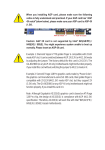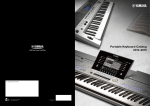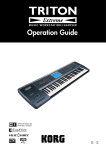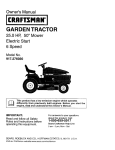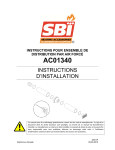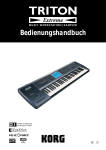Download 1739KB - Yamaha
Transcript
Congratulations! Your SY35 Music Synthesizer offers extraordinary musical versatility and control with a “vector synthesis” system than combines Yamaha’s advanced AWM sample playback technology with high-performance FM tone generation. Vector synthesis allows you to create and control synthesized sound with unprecedented ease — in a very intimate, “human” way, putting you more closely in touch with your instrument and music. The vector control lets you blend sounds manually in real time, and dynamic vectors let you “ r e c o r d ” dynamic vector sweeps that will play automatically whenever you play a note. For even more expressive capability, the SY35 keyboard features both velocity sensitivity and after-touch response that can be assigned to a number of musical parameters. The more you play the SY35, the more you’ll find that “vectors” will become an indispensable part of your musical repertoire. ● ● ● ● ● ● ● ● ● ● ● ● ● ● ● ● Yamaha AWM and FM tone generators for superior sound and tonal versatility. 2-element or 4-element voice architecture brings AWM and FM waveforms together. Vector control for 2-axis control of element level and detuning. Dynamic level and detune vectors can be recorded easily in real time. 128 preset AWM waveforms and 256 preset FM waveforms — all in an extended waveform ROM for superior sound quality — provide an extensive library of sonic “building blocks” from which to create new voices. 64 preset voices plus 64 editable internal voice memory locations containing an additional 64 voices. External memory cards provide limitless backup and storage capability. Easy-edit features make creating new voices quick and virtually programming-free. Detailed programming parameters for in-depth programming when necessary. Fully programmable 8-part multi-play mode is perfect for sequencer-driven applications, layered multi-voice performance, and split keyboard effects. 16 preset multi-play setups plus 16 editable internal multi-play memory locations containing an additional 16 multi-play setups. 16 internal digital effects including reverb and delay and distortion. Overlapping voice selection capability for seamless voice transitions. Velocity and after-touch sensitive keyboard. Pitch bend and modulation wheels. Stereo output. CONTENTS Getting Started Manual Precautions............................................................3 About the Manuals.................................................5 The Getting Started Manual ..............................5 Icons.................................................................6 The Feature Reference Manual..........................7 The Controls & Connectors ..................................8 Front Panel .......................................................8 Rear Panel.......................................................12 1. Setting Up Your System..................................14 Connections....................................................14 Power-on Procedure........................................14 Play the Demo ................................................15 4. Instant Voice Programming............................ 31 For Serious Voice Editing ….......................... 33 5. The Multi Mode............................................. 34 Try Out the Preset Multi Setups...................... 34 When You Want To Create an Original Multi …....................................................... 37 The INTERNAL and CARD Memories........... 37 Multi Polyphony & Dynamic Voice Allocation ................................................... 37 Using the [STORE] Key to Store Voices and Multi Setups in INTERNAL or CARD Memory........................................... 38 Conclusion..................................................... 40 Glossary.............................................................. 41 2. Selecting And Playing Voices ..........................16 Play the Presets ...............................................16 The PRESET, INTERNAL, and CARD Voice Memories...........................................19 Overlapping Voice Selection...........................20 3. Vectors ...........................................................21 Manual Vector Control ...................................21 How the VECTOR CONTROL Works..............22 Advanced Control: Dynamic Vectors ..............24 Try Out the SE*Elect Dynamic Vector ...........24 Recording An Original Dynamic Vector .........25 Store Your Voice & Vector In INTERNAL Memory...............................28 For More Detailed Vector Control … ..............30 Index .................................................................. 44 Getting Started Manual Precautions !! PLEASE READ THIS BEFORE PROCEEDING !! 1. AVOID EXCESSIVE HEAT, HUMIDITY, DUST AND VIBRATION Keep the SY35 away from locations where it is likely to be exposed to high temperatures or humidity — such as near radiators, stoves, etc. Also avoid locations which are subject to excessive dust accumulation or vibration which could cause mechanical damage. 2. AVOID PHYSICAL SHOCKS Strong physical shocks to the SY35 can cause damage. Handle it with care. 3. DO NOT OPEN THE CASE OR ATTEMPT REPAIRS OR MODIFICATIONS YOURSELF This product contains no user-serviceable parts. Refer all maintenance to qualified Yamaha service personnel. Opening the case and/or tampering with the internal circuitry will void the warranty. 4. MAKE SURE POWER IS OFF BEFORE MAKING OR REMOVING CONNECTIONS Always turn the power OFF prior to connecting or disconnecting cables. 5. HANDLE CABLES CAREFULLY Always plug and unplug cables by gripping the connector, not the cord. 6. CLEAN WITH A SOFT DRY CLOTH Never use solvents such as benzine or thinner to clean the unit. Wipe clean with a soft, dry cloth. 7. ALWAYS USE THE CORRECT POWER SUPPLY Always use the supplied AC Adaptor to power your SY35 or, if the original adaptor is lost or broken, a replacement or equivalent type obtained from your Yamaha dealer. Also, make sure that the adaptor you have is appropriate for the AC mains supply voltage in the area where you intend to use the SY35 (the correct INPUT voltage is marked on the adaptor). 8. ELECTRICAL INTERFERENCE Since the SY35 contains digital circuitry, it may cause interference and noise if placed too close to TV sets, radios or similar equipment. If such a problem does occur, move the SY35 further away from the affected equipment. 9. MIDI CABLES When connecting the SY35 to MIDI equipment, be sure to use high-quality cables made especially for MIDI data transmission. Also avoid cables longer than about 15 meters, as longer cables can pick up electrical noise that can causes data errors. 3 10. MEMORY BACKUP The SY35 contains a special backup battery that will retain the contents of the internal RAM memory for up to approximately five years from the date of manufacture. When the battery finally fails the contents of the RAM memory will be lost, so we recommend that you make regular backup copies of important data by transferring the data to external memory cards (see page 41 of the Feature Reference manual for information on card data storage). For even greater security (memory card data can be lost due to battery failure, accidental erasure, etc.) save your data to floppy disk via a MIDI data filer unit such as the Yamaha MDF2. Have the backup battery replaced by qualified Yamaha service personnel (see your Yamaha dealer) after approximately 5 years. IMPORTANT!: Yamaha cannot be held responsible for data loss caused by backup failure or improper operation of the SY35! 11. THIRD-PARTY SOFTWARE 4 Yamaha can not take any responsibility for software produced for this product by third-party manufacturers. Please direct any questions or comments about such software to the manufacturer or their agents. About the Manuals The SY35 comes with two manuals — Getting Started and Feature Reference. ● The Getting Started Manual (this manual) In addition to an overview of the SY35 controls and connectors (page 8), the Getting Started manual contains five separate tutorials that take you step-by-step through the main procedures you will need to know to become familiar with your SY35: 1. Setting Up Your System [Page 14] Basic system connections. 2. Selecting And Playing Voices [Page 16] Selecting and playing voices from the PRESET, INTERNAL and CARD voice banks. 3. Vectors [Page 21] Using and understanding manual and dynamic vectors. 4. Instant Voice Programming [Page 31] The fast way to create an unlimited range of new voices for the SY35. 5. The Multi Mode [Page 34] Play several voices simultaneously, or control multiple SY35 voices from an external MIDI sequencer. We recommend that you go through the tutorials in sequence while actually carrying out procedures on your SY35. Once you’ve gone through the entire TUTORIALS section in this way, you should be familiar enough with the SY35 to need only the Feature Reference manual in future. 5 ● The Feature Reference Manual The Feature Reference manual is the “nuts and bolts” reference for the SY35, individually describing its many functions in detail. The Feature Reference manual is divided into eight main sections, each describing the various functions within a particular SY35 edit or utility mode. 1. 2. 3. 4. 5. 6. 7. 8. VOICE COMMON [Page 3] VOICE VECTOR [Page 9] ELEMENT TONE [Page 15] ELEMENT ENVELOPE [Page 25] MULTI [Page 33] UTILITY SETUP [Page 39] UTILITY RECALL [Page 47] UTILITY MIDI [Page 51] Once you have become familiar with the way the SY35 works by going through the Getting Started manual, you should only need to refer to the Feature Reference manual from time to time to get details on functions you’ve never used before, or refresh your memory about functions that you don’t use very often. Each section of the Feature Reference manual has its own table of contents, so you should be able to locate any particular function quickly and easily. Functions and references can also be located by referring to the index at the back of the manual. 7 2. Selecting And Playing Voices The first thing you’ll want to do with your SY35 is select and play some of its outstanding voices … this section will show you how to do just that. We’ll also look at the overall SY35 voice memory configuration. Play the Presets Although the SY35 can access three different voice memories — PRESET, INTERNAL, and CARD — let’s begin by selecting and playing some of the preset voices. 1 Select the Voice Play Mode If the MODE [VOICE] key indicator is lit, then the Voice Play mode is already selected and you can go directly to the next step. If it isn’t, press the [VOICE] key to select it. The words “VOICE PLAY” also appear on the top line of the LCD panel when the Voice Play mode is selected. VOICE PLAY P11 AP:Rock 2 16 Select the PRESET Voice Memory If the MEMORY [PRESET] key indicator is already lit, then the PRESET voice memory is already selected and you can go straight to the next step. If it isn’t, press the [PRESET] key to select it. PRESET VOICE LIST No. Voice Name No. Voice Name No. Voice Name No. Voice Name 11 12 13 14 15 16 17 18 AP:Rock AP:Clsic AP*Chors AP:HTonk AP:Soft AP*Pf&St AP:Blend AP*Bell 31 32 33 34 35 36 37 38 BR:Trmpt BR:Mute BR:Tromb BR:Flugl BR:FrHrn BR*Sect1 BR*Sect2 BR*Fanfr 51 52 53 54 55 56 57 58 BA:Wood BA:Frtls BA*Slap BA:Fingr BA:Pick BA:Synth BA:Tchno BA:Groov 71 72 73 74 75 76 77 78 PL:Gypsy PL:Folk PL*Wide PL*Mute PL:Rock PL*Dist PL:Chrng PL:Sitar 21 22 23 24 25 26 27 28 EP*Tine EP:Light EP:Old EP*Malet KY*Clav1 KY:Clav2 KY:Celst KY:Hrpsi 41 42 43 44 45 46 47 48 ST*Arco1 ST:Arco2 ST:Cello ST*SlwAt ST*Pizz ST*Treml ST*OrchB ST*OrchS 61 62 63 64 65 66 67 68 WN:Sax WN:Flute WN:Clari WN:Oboe WN *PanFl WN *SaxEm WN *Ensmb WN *Orch 81 82 83 84 85 86 87 88 CH *Pure CH *Itopy CH *Uhh-CH *Angel CH *Bell CH *Snow CH *Vcodr CH *Marin INTERNAL VOICE LIST No. Voice Name No. Voice Name No. Voice Name No. Voice Name 11 12 13 14 15 16 17 18 SP*Warm SP*Resnc SP*Full! SP*Bell SP*Filtr SP*Deep SP*Fog SP*Dyna 31 32 33 34 35 36 37 38 SL*Saw SL:Squar SL*Sync SL*Power SL*Whstl SL*2VCO SL*Fat SL*AnaSy 51 52 53 54 55 56 57 58 BR*Punch BR*Power BR*Fat BR:Lite ST*Modrn ST*Soft ST*Mild ST:Lite 71 72 73 74 75 76 77 78 ME*Wide! ME*Drama ME*SlwSg ME*Grand ME*Typhn ME*Tzone ME*Space ME*Memry 21 22 23 24 25 26 27 28 SC*Dgcrd SC*Elgnt SC*sFz< SC*Coin SC*Brash SC:Water SC*Sand SC*Reso 41 42 43 44 45 46 47 48 OR:Tango OR:Paris OR*Rock1 OR*Rock2 OR*Rock3 OR*Cat OR*Big OR*Combo 61 62 63 64 65 66 67 68 SE*Hit SE*Start SE*Who? SE*Open SE*Emgsy SE*Elect SE*GoUp! SE*and>? 81 82 83 84 85 86 87 88 PC:Vibe PC*Marim PC:M.Box PC:Timp PC*Batl PC*Human DR *Auto DR:Kit Note that the voices are arranged in categories for easier access. For example, preset bank 1 contains acoustic piano voices, preset bank 2 contains electric piano and other keyboards, bank 3 is all brass, bank 4 is strings, and so on. The category of each voice is identified by a two-character prefix, as follows: AP = Acoustic Piano EP = Electric Piano KY = Keyboard BR = Brass ST = Strings BA = Bass WN = Wind PL = Plucked CH = Chorus SP = Synth Pad SC = Synth Comp SL = Synth Lead OR = Organ SE = Sound Effect ME = Musical Effect PC = Percussive DR = Drums Also note that the delimiter which separates the category prefix from the voice name indicates whether the voice is a 2-element or 4-element type: colon (:) = 2-element voice, asterisk (*) = 4-element voice. A more detailed voice list is provided in the Feature Reference manual appendix, on page 59. 18 3. Vectors Vectors are a versatile musical tool. You can simply use the VECTOR CONTROL as an expressive controller while playing, or spend some time programming sophisticated “dynamic vectors” that play automatically. Manual Vector Control Before we get into the details of vector synthesis, try using the VECTOR CONTROL with some of the preset voices to get a feel for what this versatile feature can do. 1 Select the Vector Play LEVEL Mode While in the Voice Play mode (see the preceding section if you don’t know how to select the Voice Play mode), turn the Vector Play mode ON by pressing the VECTOR PLAY [ON/OFF] key so that either the [LEVEL] or [DETUNE] indicator lights, then press the [LEVEL/DETUNE] key to select the [LEVEL] indicator (the [LEVEL] and [DETUNE] indicators are selected alternately when the key is pressed). 2 Select the SP* Bell Voice The SP* Bell voice (INTERNAL bank 1, number 4) is a good choice to experiment with the VECTOR CONTROL. VOICE PLAY I14 SP*Bell 3 Move the Vector Control While Playing Try moving the VECTOR CONTROL vertically, sideways, and in circles while you play on the keyboard, and listen carefully to how the sound changes. VECTOR CONTROL A A D C B D C B 21 4 Try DETUNE Vector Control … Press the VECTOR PLAY [LEVEL/DETUNE] key so that the [DETUNE] indicator lights, move the VECTOR CONTROL while playing, and listen for the difference in sound. 5 Also Try the Vector Control With These Voices … The following voices also effectively demonstrate the power of the VECTOR CONTROL. Select them and apply LEVEL and DETUNE vector control as you play: l l l How the VECTOR CONTROL Works P68 WN* Orch I74 ME * Grand I78 ME * Memry SY35 voices can have either a “2-element” or “4-element” configuration. Each element is actually an independent sound or “waveform,” and vector control allows the 2 or 4 different waveforms in a voice to be blended and detuned in a variety of ways — manually or automatically. The “ A , ” “B,” “C,” and “ D ” markings around the VECTOR CONTROL correspond to the voice elements. A 2-element voice uses only elements A and B, while a 4-element voice uses all four elements — A, B, C and D. VECTOR CONTROL A D A C B C D B For the sake of clarity, we'll represent the SY35 vector control by asimple graph like the one shown to the right for the rest of the tutorial. 22 LEVEL OR PITCH CHANGE VECTOR CONTROL MOTION A LEVEL OR PITCH A B D C C B D TIME Advanced Control: Dynamic Vectors In addition to the manual vector control capability described so far, the SY35 features advanced automatic vector recording and playback capability. Automatic vectors are called “dynamic vectors” in the SY35, and these play automatically whenever you play a note on the keyboard. Dynamic vectors can be recorded in real time via the VECTOR CONTROL by using the procedure described in the “Recording an Original Dynamic Vector” section, below. While manual vector control is possible whenever the VECTOR PLAY mode is ON — i.e. when either the VECTOR PLAY [LEVEL] or [DETUNE] indicator is lit, dynamic vectors operate only when the VECTOR PLAY mode is OFF — i.e. when both the VECTOR PLAY [LEVEL] and [DETUNE] indicators are out. Try Out the SE* Elect Dynamic Vector Before we dive in and record an original dynamic vector, spend a few minutes familiarizing yourself with the SE* Elect voice and its preset dynamic vector. 1 Select the SE* Elect Voice The SE* Elect voice (I66) features a distinct dynamic vector that will serve as an ideal foundation for a few initial experiments. VOICE PLAY I66 SE*Elect 2 Turn Vector Play OFF and Play the Voice Make sure the manual VECTOR PLAY mode is turned OFF, using the VECTOR PLAY [ON/OFF] key to turn it off if necessary (neither the [LEVEL] or [DETUNE] indicators should be lit). Play a nice long note or chord. Notice how the various elements are gradually brought in and blended automatically — this is the result of a dynamic vector. 24 3 Turn Vector Play ON Now press the VECTOR PLAY [ON/OFF] key to turn the VECTOR PLAY mode ON, and select [LEVEL] control. Since Vector Play is ON, the dynamic vector will not play. Set the VECTOR CONTROL to center position and play another note or chord. You should hear all 4 elements at the same time, in approximately equal proportions. Play with the VECTOR CONTROL a bit to get a feel for this particular combination of elements. VECTOR CONTROL A D A C B Recording An Original Dynamic Vector D C B Now we’ll go ahead and record an original dynamic level vector for the SP* Bell voice. 1 Select the VOICE VECTOR Edit Mode The first step is to enter the VOICE VECTOR edit mode, which we do by pressing the [EDIT/UTILITY] key and then the [VOICE VECTOR] key. 2 Select the LEVEL SPEED Function If the LEVEL SPEED function does not appear immediately when you enter the VOICE VECTOR edit mode, press the [VOICE VECTOR] key a few times until it does appear (Feature Reference manual, page 11). VV>LEVEL SPEED Vector Rate 30ms 25 4 Select the LEVEL REC Function Press the [VOICE VECTOR] key once to move ahead to the LEVEL REC display. Use the [4] and [6] cursor keys to move the cursor to the STBY (standby) parameter. (The VECTOR PLAY LEVEL LED will light.) At this point the VECTOR CONTROL will be active in the level control mode, and you can rehearse the level vector you are about to record. 5 Select REC Move the cursor to the REC parameter (press the CURSOR [6] key). 6 Record the Dynamic Vector Vector recording will begin the instant you play a note on the keyboard. Play a note (or chord), and begin moving the VECTOR CONTROL. VECTOR CONTROL Í A D C B 27 1 Turn Memory Protect OFF To turn the memory protect function off, press the [UTILITY SETUP] key a few times until the MEM. PROTECT function appears. Move the cursor to the INT parameter and press the [–1/NO] or [+1/YES] key to turn the internal memory protection off. 2 Press [VOICE] Now press the [VOICE] key to return to the VOICE PLAY mode. Before actually returning you to the VOICE PLAY mode, however, the SY35 will ask you whether you want to store the voice you have just edited into one of the INTERNAL memory locations. You can skip this step and go straight to the VOICE PLAY mode by pressing the [–1/NO] key, or you can press [+1/YES] to initiate the voice storage procedure. 3 Press [+1/YES] If You Want to Store the Voice If you press [+1/YES], a display similar to the following will appear: The number of the voice you edited will be shown to the left of the lower display line, and the cursor will be placed to the right of the arrow. 29 4. Instant Voice Programming Although the SY35 allows you to program voices in considerable detail, in this section we’ll present a simple way to create an unlimited range of new and useful voices. Detailed parameters for programming individual elements are available in the ELEMENT TONE and ELEMENT ENVELOPE edit modes described in the Feature Reference manual, beginning on pages 15 and 25, respectively. Everything we need to have loads of fun — and to create some very serious voices — is available in the VOICE COMMON edit mode. 1 Select a Preset Voice To Start With Select any preset voice while in the VOICE PLAY mode to serve as a “platform” for your new voice. ST * Arco1 (P41) is a good choice to start with. VOICE PLAY P41 ST*Arco1 2 Select the VOICE COMMON Edit Mode Select the VOICE COMMON edit mode by pressing the [EDIT/UTILITY] key and then the [VOICE COMMON] key. 3 Select the RANDOM Function Press the [VOICE COMMON] key a few times until “RANDOM” appears on the top display line. As long as the cursor is on the top display line next to the function name, it is also possible to scroll backward and forward through the function list by using the [–1/NO] and [+1/YES] keys. If the “ELEMENT” parameter does not appear in the RANDOM display, as pictured above, use the CURSOR [4] and/or [6] keys to move the cursor to the left-hand parameter on the lower display line (this will either be ELEMENT, LEVEL VEC, or DETUNE VEC) and, if necessary, select “ELEMENT” using the [–1/NO] and [+1/YES] keys. 31 For Serious Voice Editing … You’re now equipped to create a world of vibrant and very useful new voices with very little actual programming indeed. If you do want to get deep into the details and fine tune your voices until they are perfect, please take the time to read through the Feature Reference manual. In it, each editing function is described individually, often with a few helpful hints that will help you use it most effectively. 33 Conclusion 40 In the preceding tutorials we’ve covered quite a lot of ground, and by now you should be quite familiar with the SY35. You know how to select and play the voices, how to use manual vector control, how to record dynamic vectors and store the results in memory, how to quickly create new voices, and how to use the multi mode. When you get the urge to go further, please take the time to read through the Feature Reference manual … or at least the section or sections that pertain directly to what you want to do. The more you program and play, the easier it will be! Glossary If you’re relatively new to electronic music, you might be confused by some of the jargon you run across in the literature you read (such as this manual). The following is a very brief glossary of some terms that are unique to this field. Aftertouch Aftertouch response refers to the capability to vary the sound of a note after the note has been struck on the keyboard. This is normally accomplished by varying finger pressure on the key. Depending on the synthesizer, aftertouch can be used to bend the pitch of a note, apply modulation, or apply just about any other effect. In the SY35 aftertouch can be assigned to pitch bend, level control, pitch modulation, or amplitude modulation. AWM Synthesis AWM stands for “Advanced Wave Memory,” Yamaha’s sophisticated sampling technology that allows high-fidelity reproduction of digitally recorded “live” sound. Cent Just as a cent coin is one-hundredth of a dollar, a cent in musical lingo is onehundredth of a semitone. The cent is a useful unit when dealing with very small changes in pitch — such as in synthesizer tuning or detuning functions. Element Normally the word “element” refers to a part of something larger. The same applies in synthesizers. In Yamaha synthesizers, an element is an individually controllable part of a voice. In the SY35, each voice can have two or four elements. Each element is actually an independent waveform, so you could have a 4-element voice that is made up of a piano element, a brass element, a strings element, and a wind element. Envelope You’ll hear the terms “envelope” and “envelope generator” quite a lot in synthesizer talk. Like the envelope that encloses a letter, a synthesizer envelope “encloses” the sound, mainly in one of two ways. An amplitude envelope determines the overall “shape” of the sound — i.e. the speed and shape of the attack, how fast the sound decays, etc. A pitch envelope determines how the pitch of a note changes over time. Next to the basic waveform, the amplitude and pitch envelopes are the most important factors in determining how a voice sounds. FM Synthesis FM is Yamaha’s proven Frequency Modulation synthesis technology which is capable of creating extraordinarily warm, vibrant simulations of actual instruments, as well as an infinite variety of original sounds. The reason for the “ F M ” name is that this tone generator system employs a number of independent oscillator blocks known as “operators,” that are arranged in a variety of configurations known as “algorithms.” Depending on their positions in the algorithm, each operator functions either as a “modulator,” or a “carrier” that is modulated by a modulator. Since modulators modulate the frequency of carriers, the system is a form of frequency modulation — therefore, “FM Synthesis.” 41 LFO LFO stands for “Low Frequency Oscillator.” This is the oscillator, usually with a frequency variable from about 0.1 to 20 hertz, that is responsible for creating the periodic variation in tremolo, vibrato, chorus, phasing, and other modulation type effects. MIDI “MIDI” is an acronym standing for “Musical Instrument Digital Interface.” MIDI allows musical instruments, sequencers, signal processing devices, computers, and other devices to communicate and control each other via a simple cable connection. The introduction of MIDI has revolutionized the music field, making control of the music production process easier and more efficient than ever before. Modulation In synthesizers, the term “modulation” usually means to vary the amplitude or frequency of a sound in accordance with some other signal. This “other signal” is most commonly the output from the synthesizer’s LFO (described above), although in Yamaha FM synthesis (also see above) it can also be the signal from a modulator operator in an FM algorithm. Multi Although normally a prefix, as in “multi-talented,” the term “multi” on its own has come to refer to multi-timbre setups in the synthesizer world. A multi is usually a group of 8 or 16 voices that can be played simultaneously either from the instrument’s keyboard, sometimes in split-keyboard configurations, or via MIDI. For MIDI control each voice receives on a different MIDI channel number, allowing multi to be handled as multiple tone generators by the controlling sequencer or computer. Multis also allow a number of parameters to be programmed individually for each voice: volume, pitch, effects, etc. Pan The word “pan” is derived from the “pan pot” controls found on mixing consoles, which is in turn derived from “panoramic potentiometer.” A pan control or parameter determines the position of a specific sound — e.g. an element of a voice or a drum instrument — within the output stereo sound field. Panning to the left means that more of the corresponding sound is delivered via the left channel than the right channel, and vice versa. The listener then hears the sound at the appropriate position between the stereo speakers or headphones. Preset A “preset” can be any unit of data — a voice or multi (see above), for example — that is pre-programmed by the manufacturer and provided with a synthesizer. Presets make life easier for beginning synthesizer users as well as performance-oriented players who simply want to select a sound and play without having to do any programming of their own. The quality of the presets included with an instrument is therefore critical to the value of the instrument. Vector Mathematically speaking, a “vector” is a physical quantity with both magnitude and direction. This applies in a similar way to vector synthesis in that the vector control controls the magnitude and direction of a quantity that can be pitch or level. 42 Velocity Normally, velocity is simply defined as speed. In a synthesizer, however, it generally refers specifically to the speed with which the keys are played. When we think of playing a keyboard we normally think of playing the keys softer or harder to produce softer and louder notes with the attendant timbre variations. In reality, however, the instrument is responding to how fast the keys are played — therefore the term “velocity response.” A synthesizer that has velocity response lets the player produce expressive dynamics and timbre variations according to the way he or she plays the keys. Voice Although this term is used in slightly different ways by different manufacturers, at Yamaha a “voice” is any basic sound that can be selected and played on a synthesizer. This is in contrast to a “performance” which is a combination of two or more voices, and a “multi” (see above) which is a group of several voices that can be controlled independently via the MIDI interface. 43 Index –1/NO and +1/YES keys 9, 17 K Keyboard 8 A AWM 23, 41 B Bank keys 11, 17 L LED display Level rec function Level speed function Level vectors Liquid crystal display C Card key Card multi memory Card slot Card voice memory Connections Cursor keys 10 37 13 20 14 9 D DC 10V-12V in jack Demo Demo key Detune vectors Dynamic vectors Dynamic voice allocation 12 15 11 22 24 37 M Manual vector control Memory backup Memory protect MIDI cables MIDI conectors Modulation wheel Multi key Multi list Multi play mode Multi polyphony N 23, 41 12 I Icons Internal key Internal multi memory Internal voice memory 44 11, 17 O 9 31 31 31 22, 41 F FM Foot volume jack 21 3 29, 38 3 13 8, 19 9 36 34 37 Number/multi part select keys E Edit/utility/compare key Element envelope edit mode Element parameter Element tone edit mode Elements 10 27 25 21 10 6 10 34, 37 17, 20 Output jacks Overlapping voice selection 12 20 P Phones jack Pitch bend wheel Power supply Power switch Power-on procedure Preset key Preset multi memory Preset voice memory 12 8, 19 3 12 14 10 34, 37 16, 19 R Random function 31 S Store Store key Sustain jack 28 10, 38 13 V Vector control Vector play keys Vector rate Vectors Voice categories Voice common edit mode Voice key Voice list Voice play mode Voice vector edit mode Volume control 8, 21 8, 21, 22 26 21, 42 18 31 9 18 16 25 8 45
This document in other languages
- română: Yamaha SY35
- français: Yamaha SY35
- español: Yamaha SY35
- Deutsch: Yamaha SY35
- русский: Yamaha SY35
- Nederlands: Yamaha SY35
- dansk: Yamaha SY35
- polski: Yamaha SY35
- čeština: Yamaha SY35
- svenska: Yamaha SY35
- italiano: Yamaha SY35
- português: Yamaha SY35
- Türkçe: Yamaha SY35
- suomi: Yamaha SY35

















































